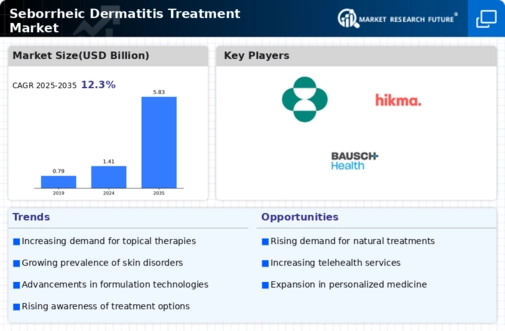Market Growth Projections
The Global Seborrheic Dermatitis Treatment Market Industry is poised for substantial growth, with projections indicating a market value of 1.41 USD Billion in 2024 and an anticipated increase to 5.83 USD Billion by 2035. This growth trajectory reflects a compound annual growth rate of 13.8% from 2025 to 2035. Such projections underscore the increasing recognition of seborrheic dermatitis as a significant health concern, prompting both healthcare providers and patients to seek effective treatment solutions. The market's expansion is likely to be driven by a combination of factors, including rising prevalence, advancements in treatment options, and growing consumer awareness.
Impact of Lifestyle Changes
Shifts in lifestyle and environmental factors are influencing the Global Seborrheic Dermatitis Treatment Market Industry. Factors such as increased stress levels, dietary changes, and urbanization are believed to exacerbate skin conditions, including seborrheic dermatitis. As individuals face these lifestyle challenges, the incidence of the condition may rise, leading to greater demand for effective treatments. Furthermore, the growing trend of self-care and wellness among consumers is likely to drive interest in products that address skin health. This evolving landscape suggests that the market will continue to adapt to the changing needs of consumers, potentially leading to sustained growth.
Growing Awareness and Education
Increased awareness and education regarding seborrheic dermatitis play a pivotal role in shaping the Global Seborrheic Dermatitis Treatment Market Industry. Public health campaigns and educational initiatives by dermatological associations have led to a better understanding of the condition among both patients and healthcare professionals. This heightened awareness encourages individuals to seek timely treatment, thereby driving market growth. As more people recognize the symptoms and seek appropriate care, the market is expected to expand significantly. The projected compound annual growth rate of 13.8% from 2025 to 2035 reflects the positive impact of these awareness initiatives on treatment adoption.
Advancements in Treatment Options
Innovations in treatment modalities significantly influence the Global Seborrheic Dermatitis Treatment Market Industry. The introduction of novel therapies, including topical antifungals, corticosteroids, and newer formulations, enhances treatment efficacy and patient compliance. For instance, the development of combination therapies that address multiple symptoms simultaneously has shown promising results. These advancements not only improve patient outcomes but also stimulate market growth as healthcare providers adopt more effective treatment protocols. As the market evolves, the anticipated growth to 5.83 USD Billion by 2035 underscores the importance of continuous innovation in addressing seborrheic dermatitis.
Rising Demand for Over-the-Counter Products
The Global Seborrheic Dermatitis Treatment Market Industry is witnessing a surge in demand for over-the-counter (OTC) products. Many patients prefer accessible and convenient treatment options that do not require a prescription. The availability of various OTC shampoos, creams, and lotions formulated specifically for seborrheic dermatitis has empowered consumers to manage their symptoms effectively. This trend is particularly pronounced in regions with limited access to healthcare professionals. As the market adapts to consumer preferences, the growth trajectory appears promising, with OTC products likely contributing significantly to the overall market expansion.
Increasing Prevalence of Seborrheic Dermatitis
The Global Seborrheic Dermatitis Treatment Market Industry experiences growth driven by the rising prevalence of seborrheic dermatitis. This skin condition affects millions worldwide, with estimates suggesting that approximately 3% to 5% of the global population is impacted. The condition is particularly common among adults aged 30 to 60 years, leading to increased demand for effective treatment options. As awareness of the condition grows, more individuals seek medical advice and treatment, contributing to the market's expansion. The projected market value of 1.41 USD Billion in 2024 reflects this trend, indicating a robust demand for therapeutic solutions.














Leave a Comment